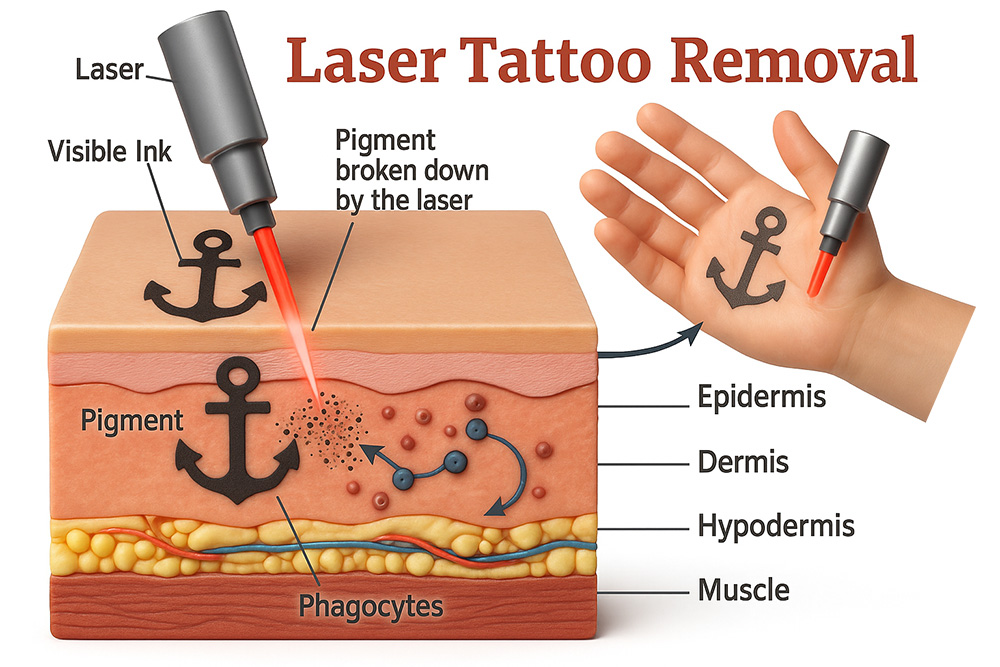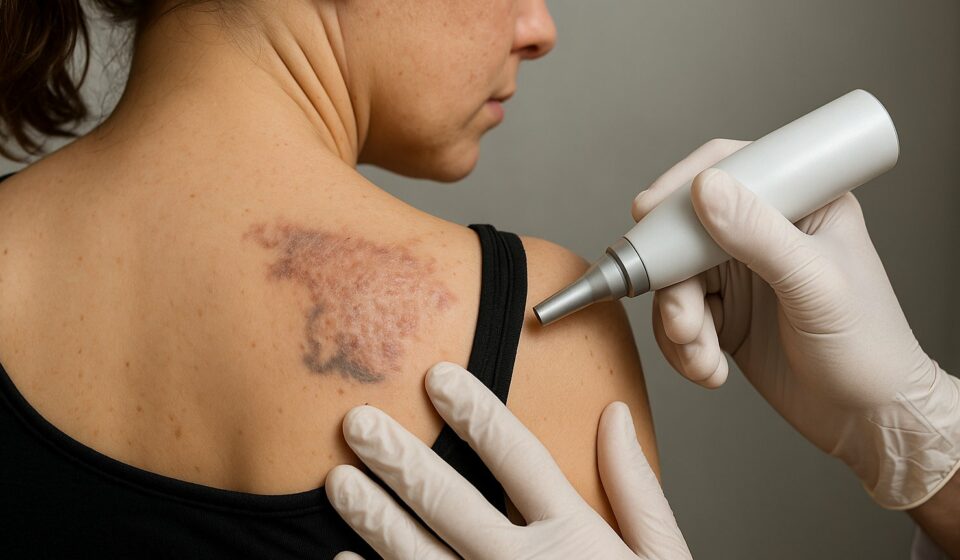Short answer: with modern Q‑switched lasers in trained hands, true scarring after tattoo removal is uncommon. Most clients see temporary redness, swelling, blistering or flaking that settles within days to weeks. A lasting scar usually stems from overtreatment, poor aftercare, picking, or a pre‑existing scar beneath the ink. Choosing a skilled provider and a high‑quality device does most of the heavy lifting to keep skin smooth as the ink fades.12
Table Of Content
- Do laser tattoo removal treatments leave scars?
- What really increases scarring risk?
- How professionals keep scarring rare
- Spotting issues early, five quick checks
- Normal reactions versus true scars
- Key aftercare practices
- When to consult a specialist
- Healing timeframes explained
- Preventing long‑term marks
- What the laser does to ink, a quick visual
- What to expect while healing
- Pigment changes versus scars
- Choosing the right provider and technology
- Does laser tattoo removal always leave scars?
- How can I reduce my personal risk?
- Are pigment changes a sign of scarring?
- The takeaway
- Essential Reads
- Sources
Do laser tattoo removal treatments leave scars?
Laser tattoo removal works through selective photothermolysis, where very short pulses of light target pigment inside the ink, breaking it into smaller fragments that the immune system clears. The laser energy is selective for pigment, which helps protect the surrounding skin. With Q‑switched Nd:YAG and 532 nm wavelengths, clinics can treat a wide variety of black and coloured inks while carefully managing energy and spot size to avoid collateral damage.13
So where do scars come from? A genuine scar means dermal injury that remodels with fibrous tissue. This can happen if settings are too aggressive, if multiple passes are stacked without adequate cooling, or if aftercare is ignored. Some tattoos also sit on top of pre‑existing scars, which may only become visible as ink lightens. Even so, when protocols are followed, permanent scarring is the exception, not the rule.1
What really increases scarring risk?
- Overtreatment: Excessive fluence, too many passes, or inadequate spacing between sessions can injure the dermis.
- Poor aftercare: Picking blisters or scabs, heavy exercise in the first 48 hours, hot tubs, or sun exposure can drive complications.
- Skin biology: A history of keloids or hypertrophic scars raises risk, as does active eczema or infection in the area.
- Pre‑existing scar tissue: Some tattoos cover scars. As pigment clears, the underlying texture may become more noticeable.
- Equipment and experience: High‑quality Q‑switched systems and an experienced operator reduce risk materially. The Nu Tatouage Plus offers precise control and reliable energy delivery designed for safe, effective clearance.
| Method | Typical scarring risk | Notes |
|---|---|---|
| Q‑switched Nd:YAG 1064 nm, 532 nm | Low | Gold standard for most inks. Temporary redness or blisters expected.1 |
| Picosecond lasers | Low | Very short pulses can improve clearance on some colours and stubborn ink. |
| Dermabrasion or surgical excision | Moderate to high | Physical removal or cutting the skin carries higher scarring potential. |
| Chemical tattoo removal | Variable | Can irritate skin, with uneven outcomes depending on formulation and technique. |
How professionals keep scarring rare
Great outcomes come from conservative settings, patience between sessions, and client education. Below is a practical checklist clinics use day to day.
- Patch test and medical history review.
- Choose wavelength for ink colour and depth, typically 1064 nm for black and 532 nm for reds and oranges.3
- Use adequate cooling and generous spacing between sessions, often 6 to 10 weeks.
- Give clear aftercare, including protection from sun and heat.
- Document with photos and adjust settings gradually.
The Nu Tatouage Plus is built to support these safeguards. Dual wavelengths, high pulse energy up to 1500 mJ, and intuitive controls help practitioners fine tune fluence and spot size for efficient clearance while prioritising skin safety. British Institute of Lasers also provides free training and certification, plus rapid UK support and a 24‑hour swap guarantee, so clinics can treat confidently.
Spotting issues early, five quick checks
Normal reactions versus true scars
Redness, pinpoint bleeding, frosting, and small blisters are normal and settle. A raised, firm, persistent mark beyond three months suggests a scar that warrants review.
Key aftercare practices
Do not pick or scrub. Keep the area clean and dry, apply a thin healing ointment as advised, avoid sunbeds and saunas, and protect from sun with clothing or high‑factor SPF once skin is closed.
When to consult a specialist
Escalate if pain increases after day two, if pus appears, or if the area remains raised and itchy for weeks. Early input keeps small issues small.
Healing timeframes explained
Surface settling in 3 to 7 days, pigment lightening over weeks as the immune system clears fragments, full assessment before each subsequent session.
Preventing long‑term marks
Respect intervals, protect from sun, and follow your clinic’s plan. Most long‑term marks trace back to rushing or picking.
What the laser does to ink, a quick visual
Below is a simple diagram showing how laser light breaks ink into smaller fragments that your immune system can remove. This helps explain why spacing between sessions matters.

For a feel of the process in practice, watch this short clip.
What to expect while healing
- First 48 hours: Warmth, redness, mild swelling. Small blisters can form, which is a normal sign the ink has absorbed energy.1
- Days 3 to 7: Flaking or light scabbing as the surface settles. Avoid gym friction, hot baths, and sun.
- Weeks 2 to 8: Gradual fading as your immune system clears particles. The area should feel more normal, even if colour remains.
Pigment changes versus scars
Temporary darkening or lightening of the skin can happen, especially in darker complexions. This usually fades over time. Nd:YAG at 1064 nm is generally the safer choice for darker skin types because it targets deeper pigment with less epidermal absorption.3 A true scar will look and feel different, often raised or indented, and it will not resolve with time on its own.
Choosing the right provider and technology
Look for a clinic that uses professional Q‑switched systems and provides patch testing, measured protocols, and clear aftercare. At British Institute of Lasers we supply the Nu Tatouage Plus, a robust dual‑wavelength Q‑switched platform designed for efficient tattoo clearance with client comfort in mind. Every device includes free training and certification, UK based support, and our 24‑hour swap guarantee to minimise downtime. You can also book a demo or request finance details to see how it would fit your clinic.
No. With professional Q‑switched lasers and correct aftercare, scarring is uncommon. Most effects are temporary and superficial.1
Choose a qualified clinic, follow aftercare precisely, avoid sun exposure, and disclose any history of keloids or recent isotretinoin use. Ask about cooling options such as the Cryo 6 which can improve comfort and reduce heat in the skin.
Not usually. Hyperpigmentation or hypopigmentation is usually temporary and fades as the skin settles, particularly when sessions are spaced and sun is avoided.3
The takeaway
True scarring after laser tattoo removal is uncommon when carried out by trained professionals using high‑quality Q‑switched technology, with careful settings and proper aftercare. Most reactions are temporary, and good spacing between sessions lets the skin and immune system do the rest. If you have a history of keloids, or the tattoo sits over a scar, speak to your practitioner so the plan can be tailored.
Essential Reads
Dr Majid Zarandouz
Majid holds a PhD in organic chemistry and has been working with laser systems for decades. His career began in the mid-1990s, when he started researching and developing laser-based technologies for medical and cosmetic applications. Over the years, he has combined scientific expertise with practical engineering to design machines that are effective, durable, and straightforward to use in real clinic settings. As director of the British Institute of Lasers, Majid continues to focus on producing equipment that meets professional standards while remaining accessible to businesses of all sizes.

